Discover the 12 Best Sights in Tivoli: Discover Hadrian’s Villa and Villa d’Este

Buongiorno, and welcome to Stefano Rome Tours—the premier tour company in Rome for unforgettable day tours from Rome and shore excursions from Civitavecchia since 2005. In this blog, we’re excited to present the 12 Best Sights in Tivoli: Hadrian’s Villa and Villa d’Este.
Tivoli, a charming hillside town just a short drive from Rome, offers an ideal escape for travelers eager to explore Italy’s rich history and artistic heritage. Home to two UNESCO World Heritage Sites—Hadrian’s Villa and Villa d’Este—Tivoli beautifully combines the opulence of ancient Rome with the elegance of the Renaissance.
Join us as we explore the must-see sights that you should not miss when visiting Tivoli whether you’re visiting from Rome or enjoying a post-cruise excursion from Civitavecchia.
12 Best Must-See Sights in Tivoli:
Hadrian’s Villa and Villa d’Este
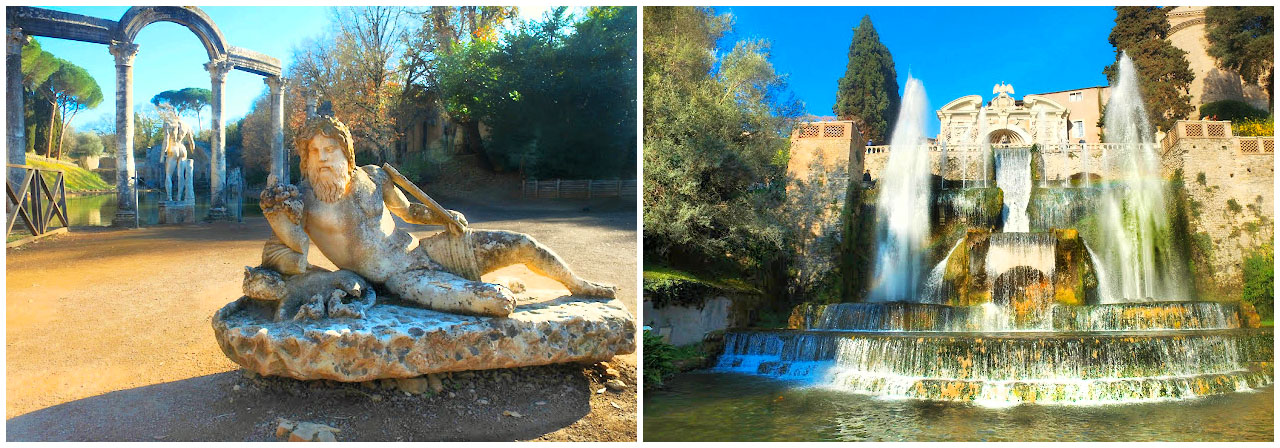
Hadrian’s Villa (Villa Adriana): Ancient Roman Imperial Retreat
Constructed in the 2nd century AD, Hadrian’s Villa—known in Italian as Villa Adriana—served as a private retreat for the Roman Emperor Hadrian, offering him a luxurious escape from the political pressures and constant bustle of Rome. This sprawling estate was more than just a residence; it was a manifestation of Hadrian’s intellectual curiosity and artistic ambition. The villa’s design embodies his admiration for various world cultures, seamlessly blending Greek, Egyptian, and Roman architectural elements into a cohesive and enchanting landscape.
Covering approximately 300 acres in its prime, Hadrian’s Villa was akin to a small city, featuring opulent palaces, thermal baths, theaters, temples, and extensive gardens. Each section of the villa reflects Hadrian's fascination with the places he visited throughout his travels, making it a mosaic of diverse cultural influences. The layout itself was revolutionary, with complex water systems, sprawling colonnades, and tranquil reflecting pools that illustrated the emperor’s appreciation for both beauty and engineering.

The list below takes you through the sites from the entrance into the archaeological site to the farthest point.
1. Pecile (Poikile)
The Pecile, or Poikile, is one of Hadrian’s Villa’s most expansive and tranquil spaces, offering a blend of architectural sophistication and natural beauty. Inspired by the famous Stoa Poikile in Athens—a colonnaded walkway known for its vibrant frescoes and a favorite gathering place for ancient philosophers—Hadrian’s Pecile captures the spirit of Greek culture in a Roman setting.
The open courtyard is surrounded by high walls that enclose a grand rectangular reflecting pool, framed by lush gardens and lined with colonnades on each side, creating a harmonious balance between built structure and open sky.
The reflecting pool serves as the focal point, mirroring the colonnades and surrounding greenery. Its serene waters provided a place for quiet contemplation and added a touch of elegance to the courtyard. The design of the Pecile was intended to evoke a sense of calm, offering a meditative space where Hadrian and his guests could take leisurely strolls or sit by the water, enjoying the villa’s peaceful surroundings.
In addition to its role as a place of reflection, the Pecile also likely functioned as an area for exercise. Roman elites often embraced the Greek ideal of combining physical fitness with intellectual pursuits, and the Pecile’s elongated layout would have been ideal for walking, running, or even philosophical discussions while taking in the beauty of the surrounding nature.
Architecturally, the Pecile stands as an homage to Hadrian’s love for Greece and his admiration for its philosophy, art, and architecture. The open-air design not only reflects Greek influences but also showcases Hadrian’s vision of an ideal world, where Roman strength and Greek intellect could coexist harmoniously. The high walls and colonnades provided shade and shelter from the elements, allowing visitors to enjoy the space throughout the day, regardless of the weather.
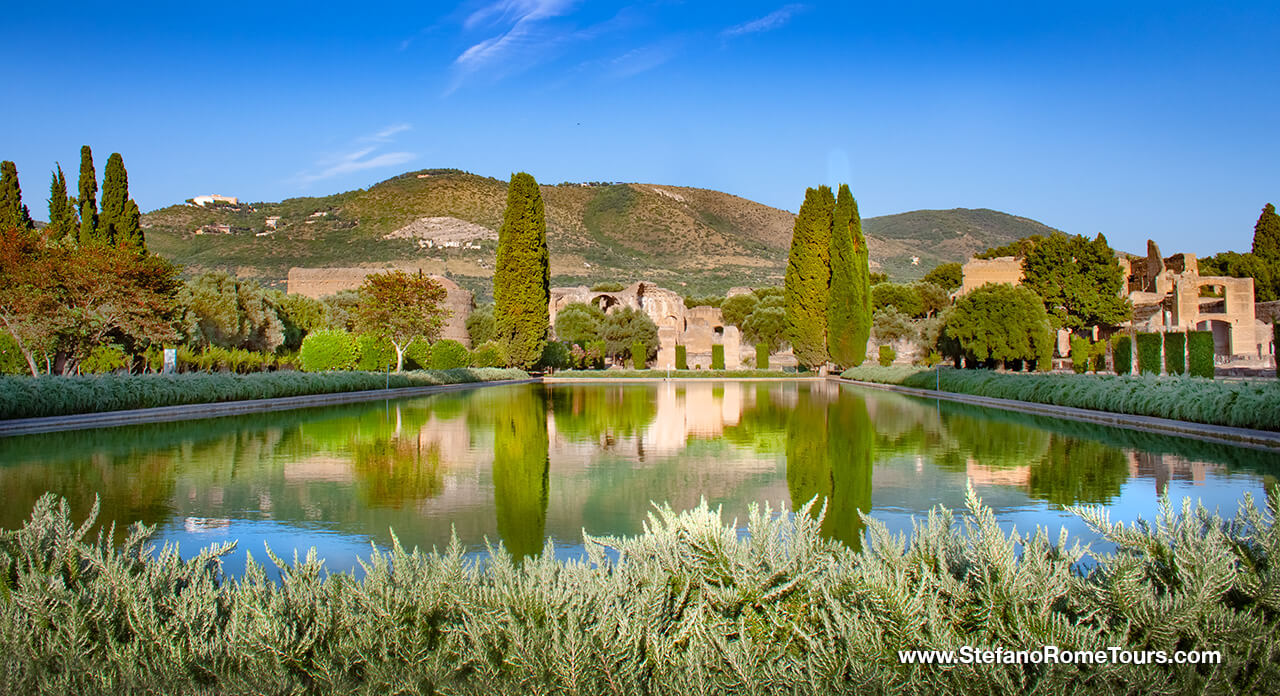
2. Maritime Theater (Teatro Marittimo)
The Maritime Theater, or Teatro Marittimo, is one of the most fascinating structures within Hadrian’s Villa, showcasing both the emperor’s desire for privacy and his admiration for innovative design. This remarkable structure functioned as a secluded island retreat within the villa itself, designed for moments of solitude and personal reflection away from the main estate.
The theater’s design is ingeniously Roman, featuring an island in the center of a shallow, circular moat, which is surrounded by a colonnaded portico. This island is only accessible by retractable wooden bridges—a clever feature that enabled Hadrian to isolate himself completely when he wished.
The island’s layout includes a small private villa with a suite of rooms, including a bedroom, bath, library, and atrium, making it a fully self-sufficient retreat within the retreat. Each section was meticulously crafted to offer Hadrian everything he needed within arm’s reach, from places for reading and resting to a private bathing area.
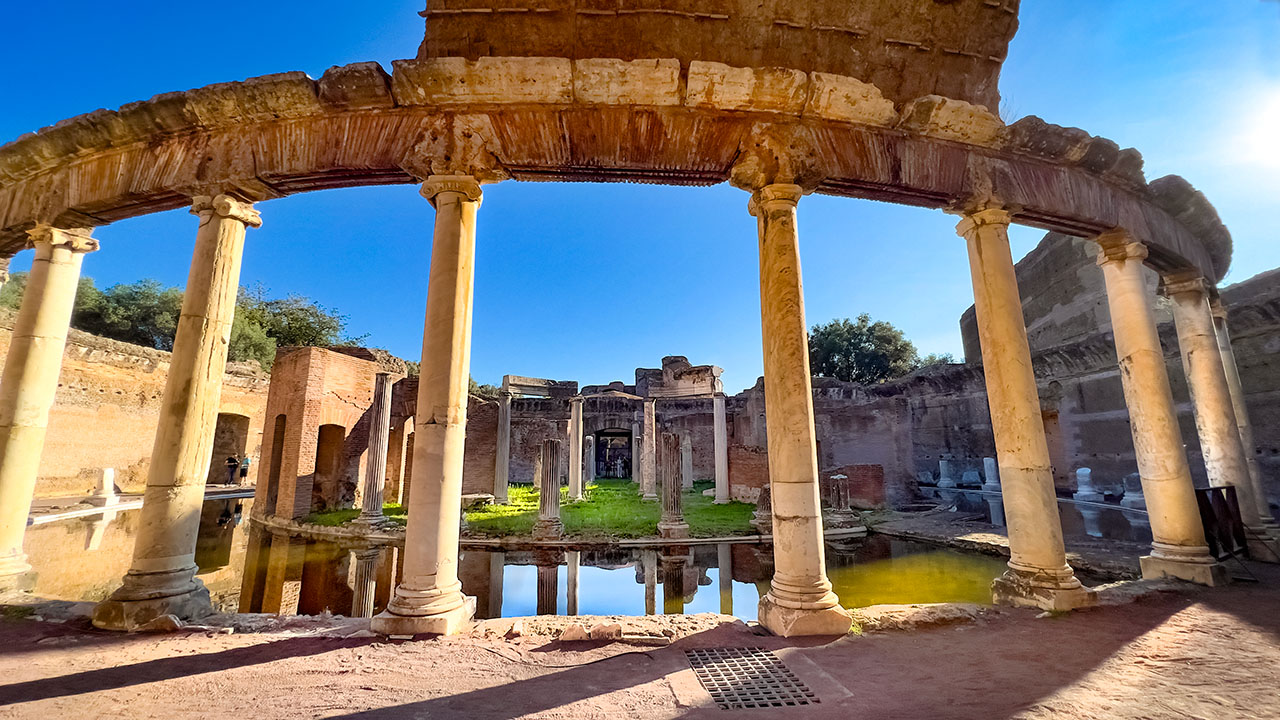
Architecturally, the Maritime Theater was groundbreaking in its use of circular symmetry and movement, demonstrating the engineering prowess of Hadrian’s era. The Ionic columns surrounding the theater and the circular portico create a rhythm of shapes and shadows, making the structure feel dynamic yet serene. The space offered Hadrian a tranquil haven where he could immerse himself in his studies, contemplate philosophical ideas, or simply escape the responsibilities of rule.
The design of the Maritime Theater reflects Hadrian’s character—intellectual, introspective, and forward-thinking. His love of Greek philosophy and architecture is evident in the structure’s simplicity and symmetry, while his affinity for privacy is seen in the isolated layout. For those visiting today, the Teatro Marittimo offers a unique glimpse into the emperor’s personal world, highlighting both his architectural ambition and his need for solitude.
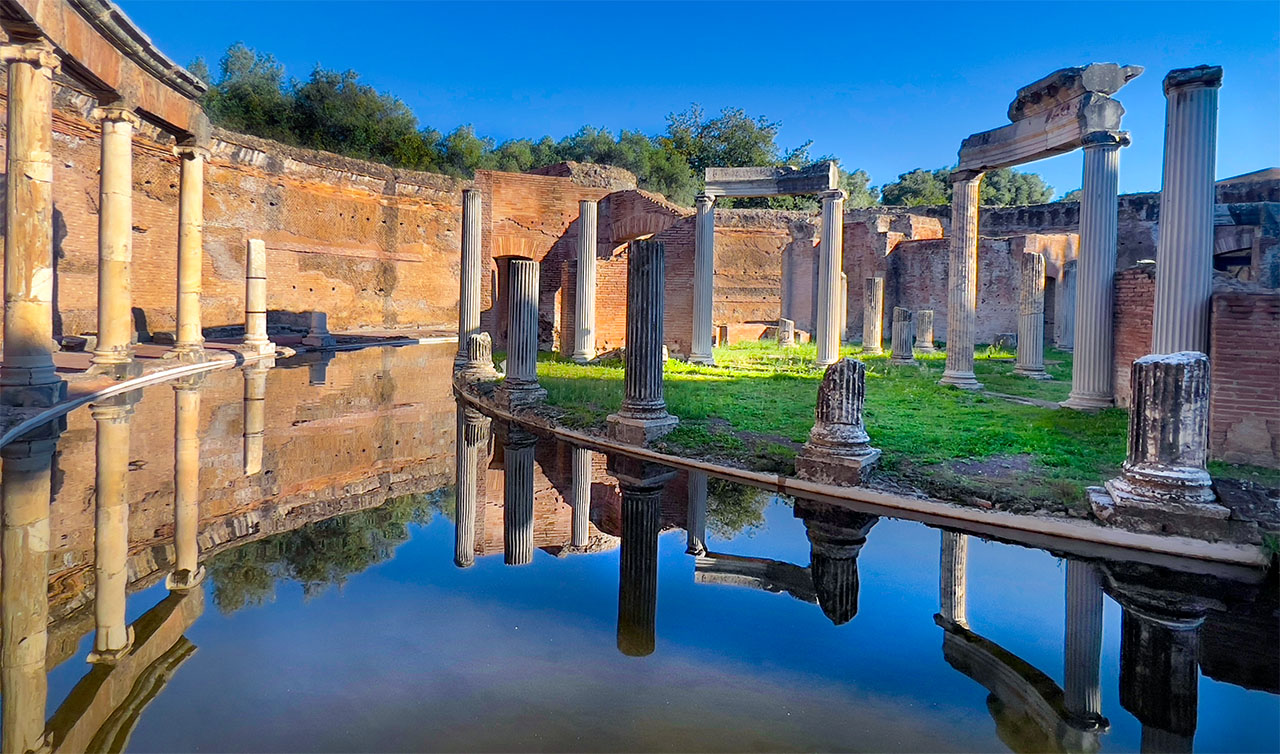
3. Thermae with Heliocaminus
The Thermae with Heliocaminus is one of the most remarkable bath complexes within Hadrian’s Villa, showcasing both the ingenuity of Roman engineering and Hadrian’s commitment to luxury and comfort. At its heart lies the heliocaminus, or “sun room”, a sophisticated architectural feature designed to capture and amplify sunlight, naturally warming the space. Unlike traditional Roman baths that relied solely on hypocaust systems—an advanced form of underfloor heating—the heliocaminus harnessed solar power to create a consistently warm environment, an early example of passive solar heating in architecture.
The heliocaminus was a circular room with large windows positioned to capture sunlight at optimal angles, allowing the heat to build up throughout the day. This warmth would then be retained by the walls and floor, ensuring a cozy temperature even during colder months.
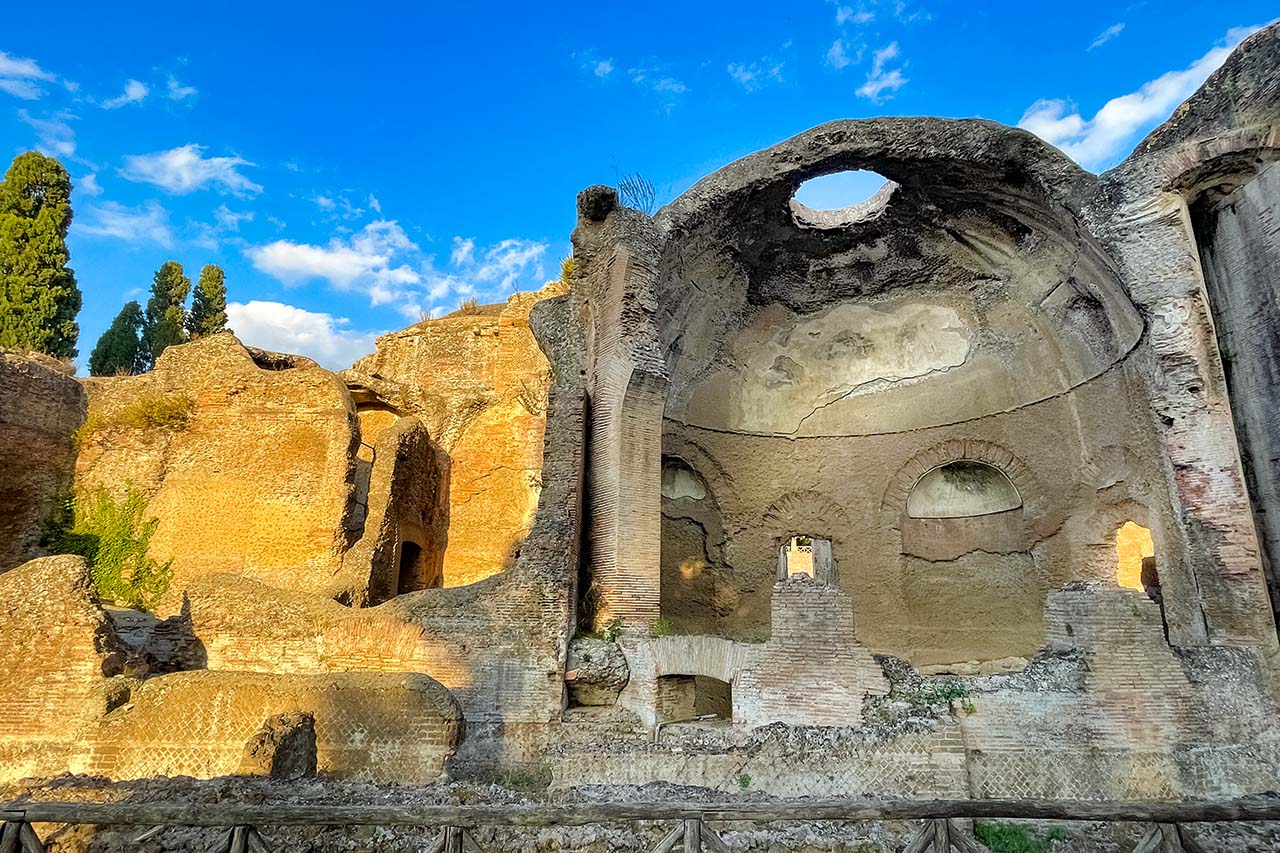
The Romans were meticulous in their understanding of materials and spatial orientation, and they used this knowledge to make the heliocaminus as energy-efficient as possible. This combination of natural sunlight and the traditional hypocaust heating system made the Thermae with Heliocaminus a marvel of comfort and sustainability.
Beyond the heliocaminus, the thermae complex featured the typical sequence of Roman baths, including a frigidarium (cold room), tepidarium (warm room), and caldarium (hot room), each with its own unique heating system. The layout was carefully planned to provide bathers with a gradual transition from cooler to warmer environments, a ritual that was essential to Roman bathing culture. The baths were adorned with exquisite mosaics and marble finishes, reflecting Hadrian’s taste for refinement and his desire to impress his guests.
For Hadrian, who spent time studying various architectural styles and engineering techniques during his travels, the Thermae with Heliocaminus was likely more than just a place for relaxation. It was an opportunity to experiment with new building methods and showcase his appreciation for technological advancement. The heliocaminus itself stands as a testament to his forward-thinking approach, merging natural elements with human innovation to create a space that was both functional and luxurious.
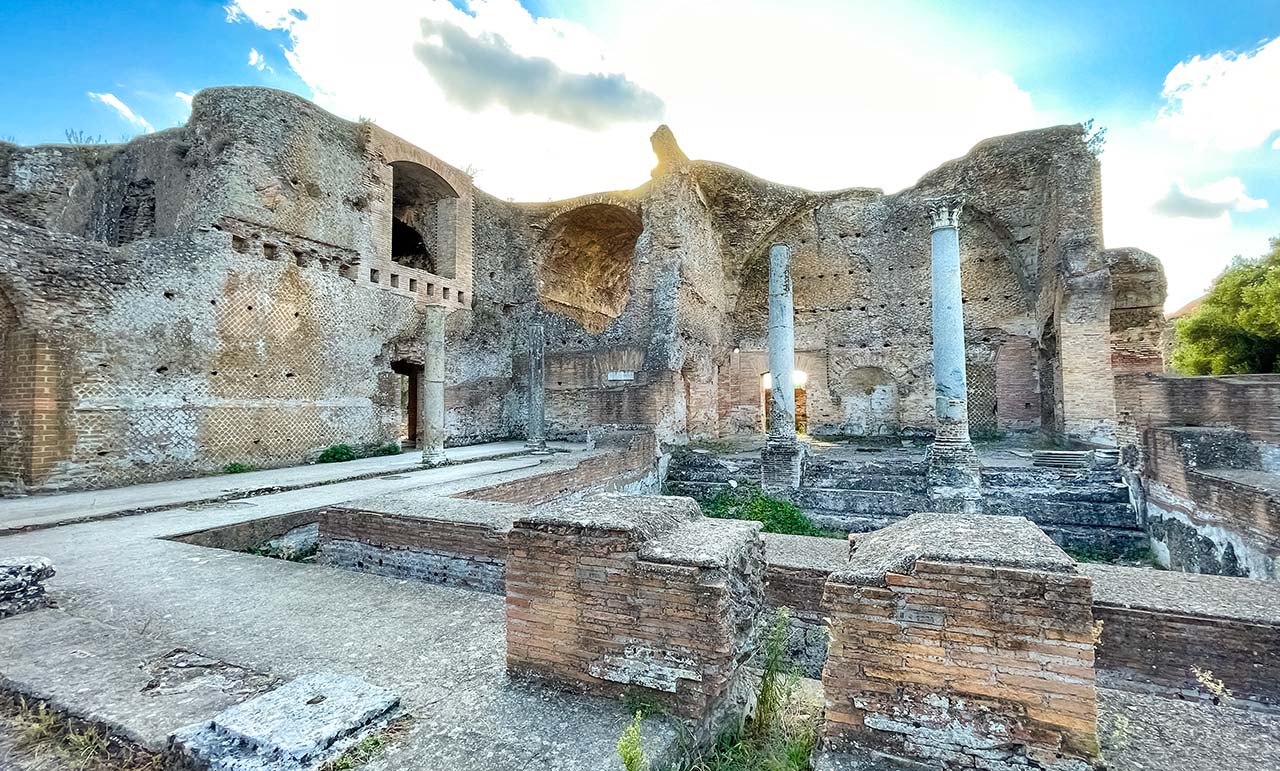
4. Hospitalia (Guest Quarters)
The Hospitalia, or guest quarters, reveal Hadrian’s emphasis on hospitality and elegance. Far from ordinary lodgings, the Hospitalia was a sophisticated space intended to ensure that Hadrian’s visitors experienced the same level of opulence and refinement as the emperor himself. This attention to detail highlights Hadrian’s dedication to providing not only comfort but also a sense of grandeur for his guests.
One of the main reasons the Hospitalia is a must-see at Hadrian’s Villa is its remarkably well-preserved mosaic floors. These checkerboard-patterned mosaics, crafted with meticulous care, are an extraordinary example of Roman decorative art that remains largely intact to this day.
The intricate design of the mosaics lends both elegance and visual appeal to the rooms, adding a rhythmic, almost hypnotic aesthetic that speaks to the Romans’ appreciation for beauty and precision. This geometric patterning, a hallmark of Roman mosaics, may also have held symbolic meaning, representing ideals such as balance and harmony—core values in Roman philosophy and culture.
Above, the vaulted ceilings create an open and airy feel, enhancing the sense of space and majesty within each room. These ceilings, with their graceful arches and architectural finesse, served not only as an aesthetic feature but also as a testament to Roman engineering prowess. The vaulted design allowed for better ventilation and acoustics, ensuring a comfortable environment that catered to both visual beauty and practical needs. Together, the mosaic floors and vaulted ceilings make the Hospitalia an exquisite blend of art and function, showcasing the elegance expected in elite Roman society.

5. Great and Small Baths (Thermae)
The Great and Small Baths, or Thermae, at Hadrian’s Villa, exemplify the luxurious and sophisticated bathing culture of ancient Rome. True to Roman tradition, these opulent bathhouses were more than just places for cleanliness; they were designed as social and leisure spaces, featuring remarkable mosaics, advanced heating systems, and elegant architectural details. The presence of both the Great and Small Baths highlights the emperor's dedication to comfort and relaxation for both his guests and himself.
The Great Baths
The Great Baths served as a primary gathering space for Hadrian’s visitors, providing a communal environment where guests could socialize, unwind, and discuss matters of the day. Decorated with intricate mosaics, this grand bathhouse displayed motifs inspired by Roman and Greek art, showcasing Hadrian’s appreciation for beauty and sophistication.
The design of the Great Baths included frigidarium (cold rooms), tepidarium (warm rooms), and caldarium (hot rooms), each serving a different purpose within the Roman bathing ritual. Visitors could move from one room to another, enjoying the various temperatures and treatments offered by the baths. This progressive flow not only provided a therapeutic experience but also allowed guests to fully indulge in the luxury of the villa.

The Small Baths
The Small Baths, in contrast, were a more private sanctuary reserved for Hadrian and his closest companions. This intimate space offered the same opulence but on a smaller scale, allowing Hadrian to enjoy moments of solitude or engage in more personal gatherings.
Like the Great Baths, the Small Baths were equipped with hypocaust systems, an advanced Roman technology that heated the floors from below by channeling warm air through a network of ducts, creating a consistently warm and inviting environment. This underfloor heating was an impressive engineering feat of its time, emphasizing the Romans’ ingenuity in creating comfortable, functional spaces.
The bathhouses’ interiors were adorned with beautiful frescoes and marble decorations, further highlighting the villa’s luxurious ambiance. The use of high-quality materials such as marble and intricate stonework speaks to the Roman commitment to creating spaces that were not only functional but also aesthetically refined.
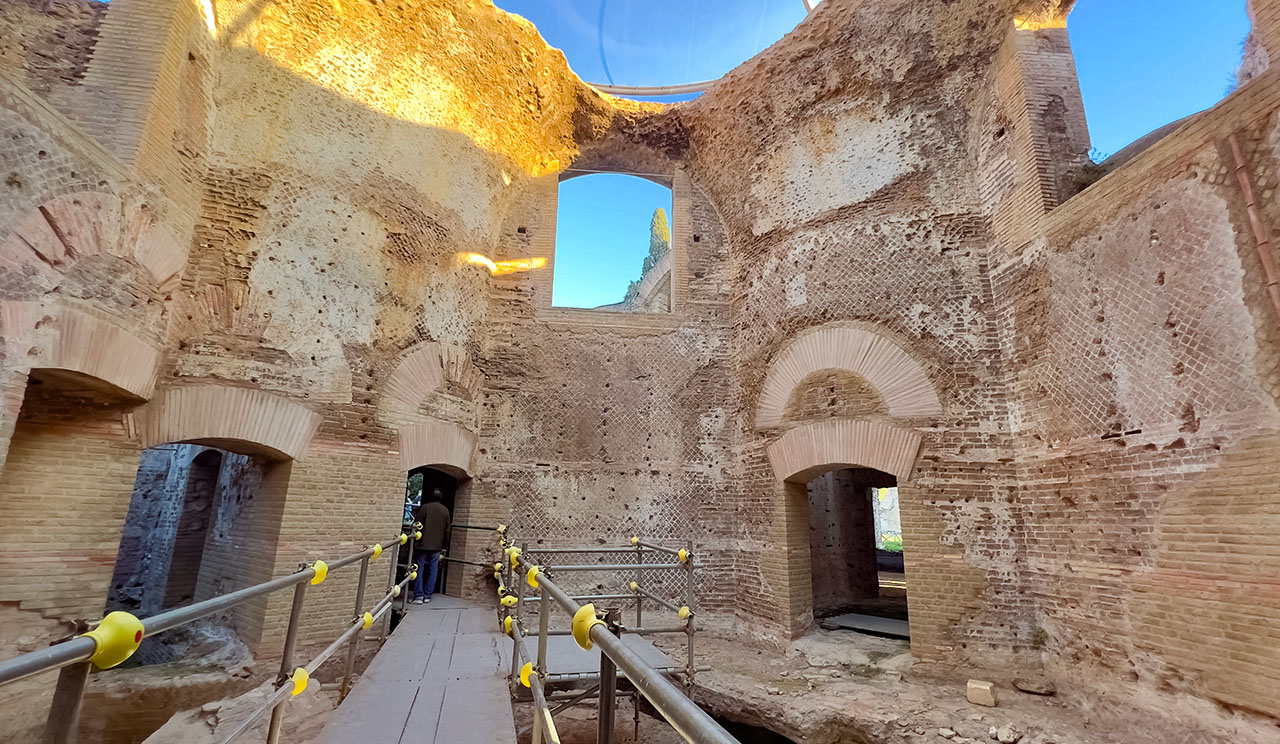
6. Canopus and Serapeum
The Canopus is one of Hadrian’s Villa’s most iconic and visually captivating features, stretching along a long, elegant pool that served as both a decorative and functional centerpiece. Inspired by the Canopus Canal in Egypt—a place famed for its religious sanctuaries and opulent gatherings—this area of the villa was Hadrian’s homage to Egyptian culture. The pool’s serene, reflective waters are flanked by a series of Corinthian columns and statues representing gods and mythological figures, creating a visual spectacle of symmetry and artistry.
At the far end of the pool stands the Serapeum, a semi-circular pavilion and one of the villa’s most intriguing structures. The Serapeum was dedicated to the Egyptian god Serapis and may have served as an elegant dining or gathering space for Hadrian and his guests, shaded by its domed roof and cooled by nearby water features. Its design incorporates a mix of Roman and Egyptian elements, with ornate carvings and intricate details that hint at Hadrian’s fascination with foreign religious practices and architectural styles.
The choice of the Canopus and Serapeum as key elements within the villa reveals Hadrian’s desire to immerse himself in a blend of cultural and spiritual worlds. It’s thought that Hadrian, who was well-versed in Egyptian culture and mysticism, created this setting as a tribute to the tranquility and mystery he encountered in his travels. The interplay between the shimmering water and the towering statues creates an ambiance that is both majestic and meditative, offering a tranquil oasis for contemplation and enjoyment.

Villa d’Este: A Renaissance Masterpiece
of Art and Waterworks
Villa d’Este is celebrated as one of the finest achievements of the Italian Renaissance, renowned for its breathtaking gardens and ingenious water features. Commissioned in the mid-16th century by Cardinal Ippolito II d’Este, son of the infamous Lucrezia Borgia and grandson of Pope Alexander VI, the villa was a statement of prestige, power, and cultural sophistication.
Ippolito, a man of wealth and influence, was appointed as the governor of Tivoli and set out to transform the villa into a residence that reflected his family’s high status and his own refined tastes.

However, the villa and its gardens were not only a display of opulence; they also represented the humanistic ideals of the Renaissance, where art, nature, and innovation converged harmoniously.
The villa was designed by the Neapolitan architect Pirro Ligorio, who drew inspiration from classical antiquity as well as the artistic movements sweeping across Europe. Ligorio envisioned Villa d’Este as a modern Eden, a paradise on earth filled with elaborate fountains, statues, and grottoes that delighted the senses and celebrated the Renaissance fascination with ancient mythology and engineering.
This ambition culminated in the villa’s elaborate garden layout—a series of terraces, walkways, and slopes that guided visitors through a carefully orchestrated landscape. Each level of the gardens offered new visual perspectives and thematic elements, creating a dynamic experience of beauty and wonder.
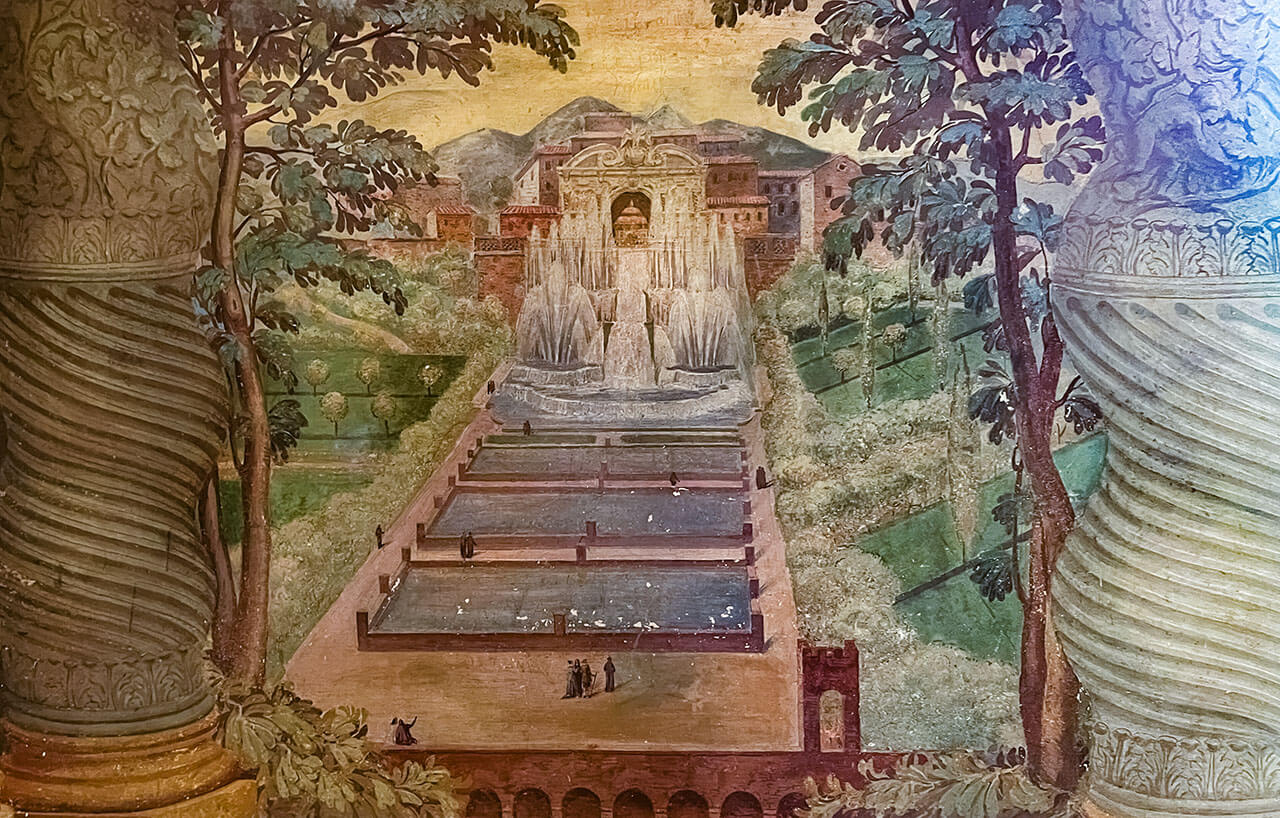
The most remarkable feature of Villa d’Este is its hydraulic engineering. Ligorio and his team of engineers implemented advanced waterworks to power the villa’s numerous fountains, without relying on modern pumps. Drawing from the nearby Aniene River, the complex system used gravity and pressure to create powerful jets and cascading waterfalls that were a marvel of their time.
The villa’s interior is equally impressive, with frescoed halls and rooms adorned with mythological scenes, landscapes, and symbolic motifs. Artists of the period painted these frescoes to evoke ancient Roman villas, creating a connection between Ippolito’s villa and the classical past he revered.
7. The Frescoed Halls Inside the Villa
Before reaching the magnificent gardens of Villa d’Este, visitors are invited to explore the interior of the villa itself, a space that reflects Cardinal Ippolito II d’Este’s refined taste and ambition to create an environment of artistic and cultural prestige. The villa’s halls are adorned with exquisite frescoes—vividly colored paintings applied directly onto wet plaster—that showcase the skill of Renaissance artists and the cardinal’s dedication to celebrating both divine and human achievements.
Inside, some of the most notable rooms include the Hall of Noah and the Hall of Glory. The Hall of Noah features frescoes that tell the story of the Great Flood, inspired by the biblical tale of Noah’s Ark. The scene is filled with intricate details, from the stormy skies to the animals and figures representing salvation.

The Hall of Glory exudes an air of opulence and grandeur, showcasing Ippolito’s aspiration to elevate the villa to a status comparable to the palaces of royalty. This room is filled with rich imagery celebrating both classical mythology and Christian symbolism, blending themes that reflect the cardinal’s sophisticated worldview. The frescoes in the Hall of Glory depict various allegorical figures, personifications of virtues, and mythological scenes that symbolize strength, wisdom, and divine favor.
In addition to these notable halls, each room of Villa d’Este has its own distinct style and thematic focus, reflecting Ippolito’s interest in a wide array of subjects—from ancient mythology and religious history to landscapes and pastoral scenes. The frescoes were created by some of the most talented artists of the time, including Federico Zuccari, Livio Agresti, and Girolamo Muziano, whose skills brought the cardinal’s vision to life.
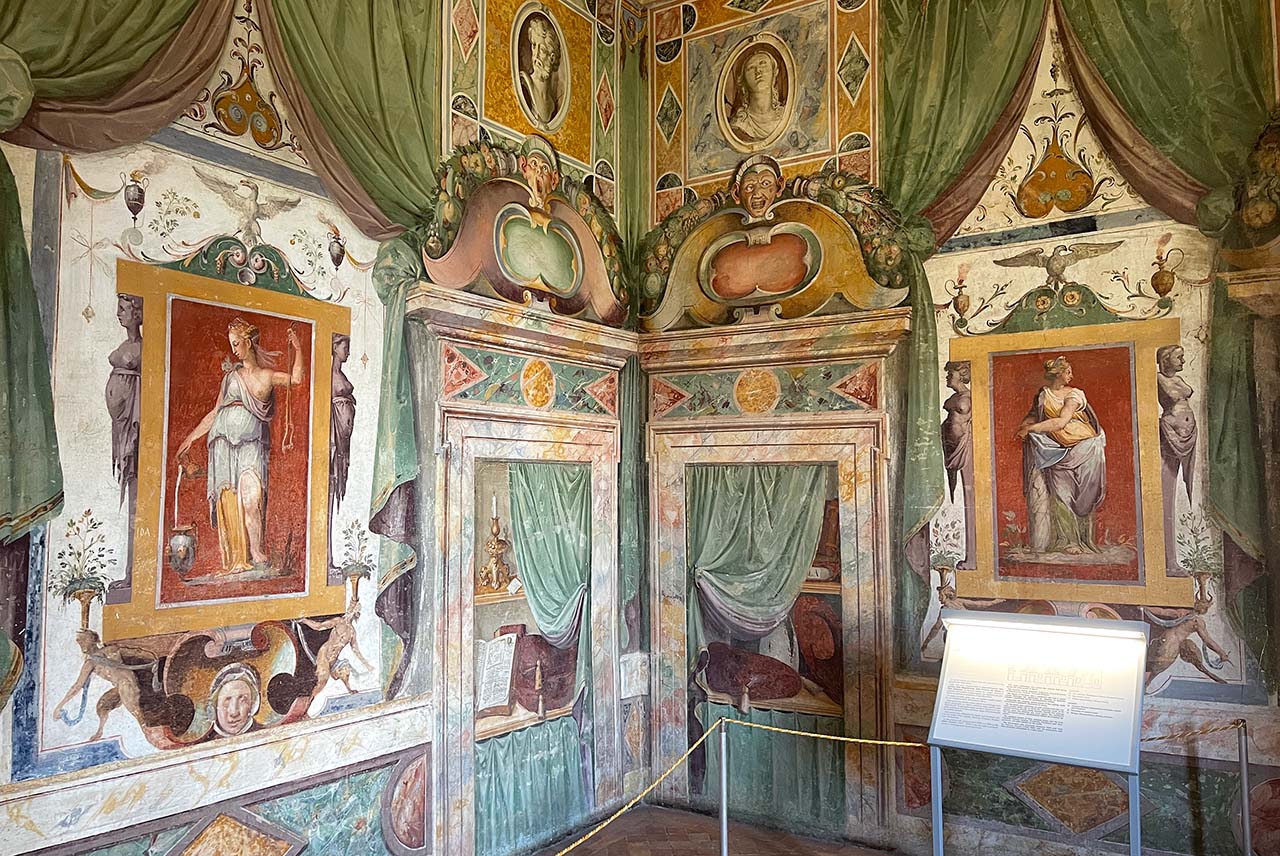
8. The Rometta Fountain (Fontana della Rometta)
The Rometta Fountain, or "Little Rome" Fountain, is one of Villa d’Este’s most symbolic and intricately designed water features. Built as a miniature representation of ancient Rome, the fountain is a captivating homage to the Eternal City, capturing the grandeur and glory of Rome in a series of carefully crafted sculptures and architectural details.
Created with immense attention to detail, the Rometta Fountain offers visitors a small-scale tour of iconic Roman landmarks, making it a fascinating destination for history enthusiasts and a powerful reminder of the historical ties between Tivoli and Rome.
At the heart of the fountain lies a sculptural depiction of the Tiber River, personified as a reclining river god with a muscular form and a flowing beard, symbolizing the life-giving water that sustained Rome for centuries. The Tiber’s image is accompanied by a symbolic she-wolf nursing Romulus and Remus, referencing Rome’s legendary founding story.
Also featured in the Rometta Fountain is a miniature representation of Capitoline Hill, one of Rome’s most significant hills and the historical seat of government. Capitoline Hill was home to important temples and the Roman Forum, and its presence in the fountain signifies Rome’s status as a center of political and spiritual power. The Rometta Fountain includes other notable elements that evoke the landmarks of ancient Rome, such as arches, columns, and statues representing various deities and figures of Roman history.
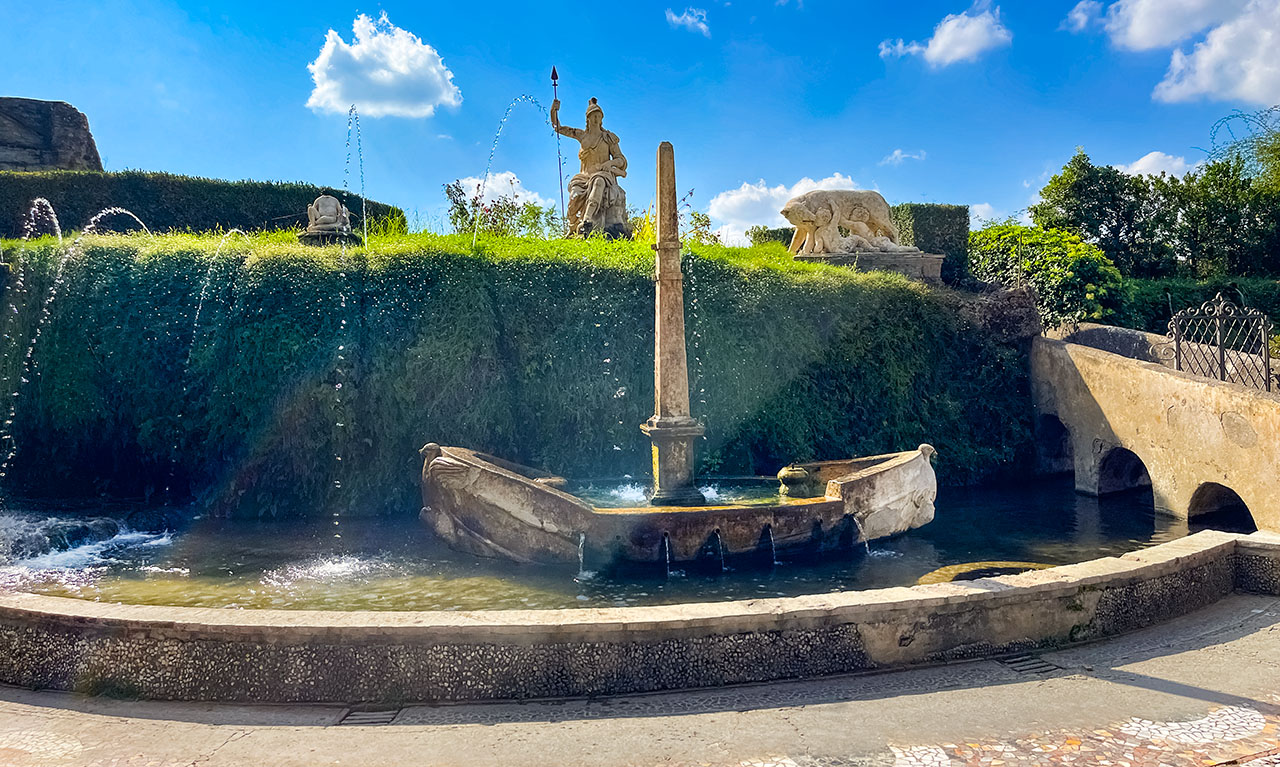
9. The Hundred Fountains (Le Cento Fontane)
The Hundred Fountains, or Le Cento Fontane, is one of Villa d’Este’s most enchanting and imaginative features. This long, picturesque pathway is lined with three parallel rows of small, whimsical fountains, creating a mesmerizing symphony of flowing water.
Historically, the Hundred Fountains likely served as a place of reflection and leisure for Cardinal Ippolito II d’Este and his guests. The grand, continuous display of water symbolizes abundance and wealth, conveying the cardinal’s status and the opulence of the villa.
Each fountain along the pathway is uniquely adorned with intricate carvings and sculptures, depicting a variety of motifs inspired by nature and mythology. Among the decorations, you’ll find sculpted flowers, animal heads, and fantastic creatures like dolphins and eagles, each carefully crafted to add character and charm to the walkway.
The fountains are fed by an intricate hydraulic system that channels water from the Aniene River, a lifeline for Tivoli and a source of inspiration for the garden’s designs. The gentle sound of water trickling, gurgling, and splashing creates a soothing backdrop, enhancing the tranquil atmosphere of the gardens.
The lush greenery surrounding the pathway, with its overhanging trees and blooming plants, completes the dreamlike setting, making it a perfect spot to pause and absorb the garden’s natural and artistic beauty.

10. The Oval Fountain (Fontana dell'Ovato)
The Oval Fountain, or Fontana dell’Ovato, is one of the most iconic and visually striking features of Villa d’Este. Situated in a lush corner of the gardens, this fountain is a masterpiece of Renaissance landscape design and hydraulic engineering, embodying the era’s ideals of balance, abundance, and harmony with nature. S
The fountain’s oval shape gives it a unique and inviting appearance, and it’s this shape that inspired its name. A semi-circular stone wall, known as an exedra, forms the backdrop for a large stone basin at the fountain’s base, which overflows with water that cascades gracefully down into the pool below.
The exedra is richly decorated with niches holding statues of Nereids (sea nymphs), each holding vases from which jets of water fan outward, creating a beautiful interplay of cascading and spraying water. The Nereids, along with other statues positioned throughout the fountain, symbolize harmony with nature, a central theme in Renaissance garden design.
The fountain is more than a display of water and sculpture; it also incorporates elements of symbolism inspired by the landscape of Tivoli. Rising above the fountain is an artificial mountain that represents the Tiburtini mountains, home to Tivoli’s famous Aniene River.
This mountain is adorned with statues that depict Tivoli’s rivers and legendary figures. The central figure is Sibyl Albunea, an ancient prophetess believed to reside in the nearby mountains, holding her son Melicertes by the hand, a symbol of Tivoli itself. Beside her, two other statues represent the rivers Aniene and Ercolaneo, sculpted by artists Giovanni Malanca and Gillis van den Vliete.
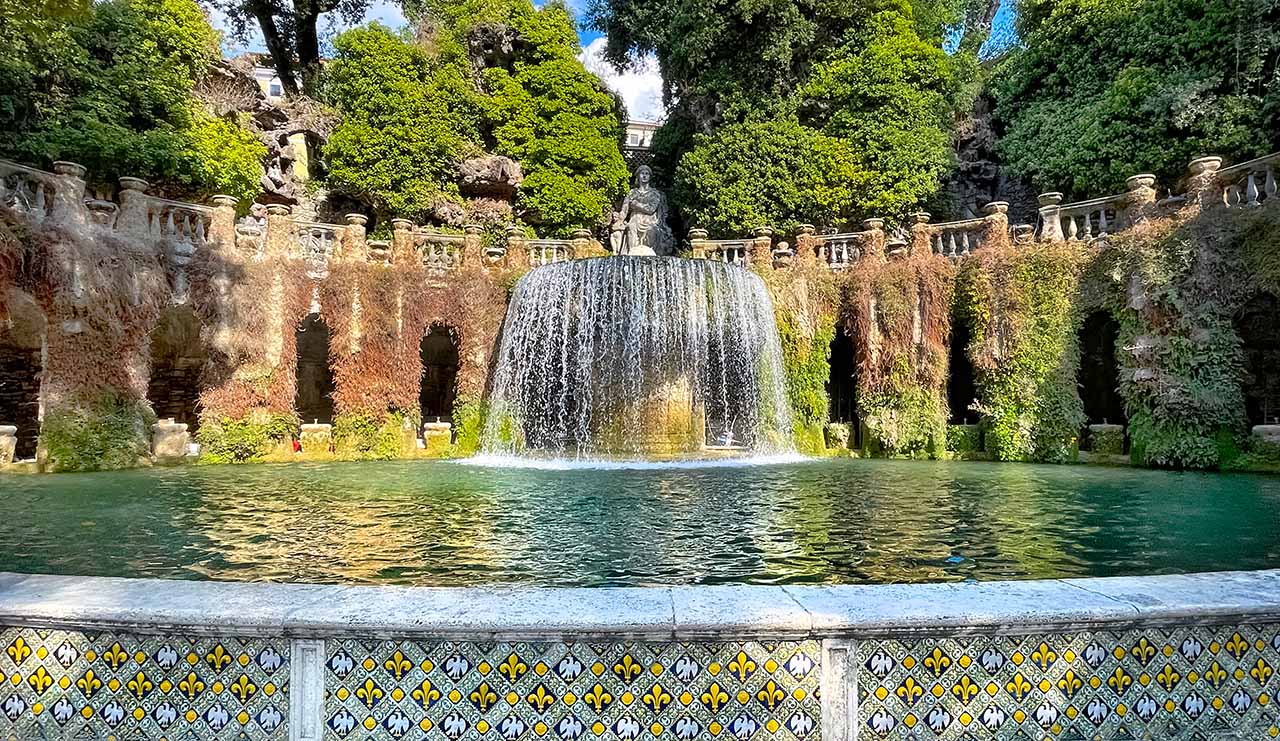
11. The Fountain of Neptune (Fontana di Nettuno)
The Fountain of Neptune is one of Villa d’Este’s most striking and powerful features, located below the Fountain of the Organ in the lower gardens. Originally designed in the 16th century by Pirro Ligorio as a dramatic cascade, it was later reimagined in the 1930s by architect Attilio Rossi to amplify its visual impact. Today, the fountain features towering water jets and multi-tiered cascades that create an impressive visual and auditory display, symbolizing the force and energy of nature.
The central jet, one of the tallest in the villa, dominates the fountain and is flanked by smaller, fan-shaped sprays, creating a dynamic, layered effect. Below the fountain, three reflective fish ponds extend into the gardens, creating a serene contrast to the fountain’s dynamic jets and enhancing the overall beauty of the lower garden landscape.
The combination of cascading water, statues, and reflective pools exemplifies Villa d'Este’s theme of using water as both a decorative and symbolic element. The Fountain of Neptune remains a focal point of the gardens, drawing visitors in with its powerful display and providing a memorable example of Villa d’Este’s integration of art, engineering, and nature.

12. The Organ Fountain (Fontana dell'Organo)
The Organ Fountain is one of Villa d’Este’s most unique and celebrated features, blending music and water in a spectacular display of Renaissance engineering. Built between 1566 and 1571 by French engineers Luc Leclerc and Claude Venard, this fountain uses a water-powered organ to produce harmonious melodies, a first-of-its-kind innovation that inspired awe throughout Europe. Water flows through a complex system of whirlpools and chambers, forcing air through pipes to create music that fills the gardens with a gentle, magical sound.
Originally, the Organ Fountain included statues of Orpheus and Apollo symbolizing music, and it was so impressive that Pope Gregory XIII inspected it, convinced a hidden musician was inside.
After falling silent for centuries, the fountain’s organ was restored in 2003 and can now play four Renaissance pieces for visitors at scheduled times, offering a rare glimpse into the marvels of Renaissance artistry and innovation.
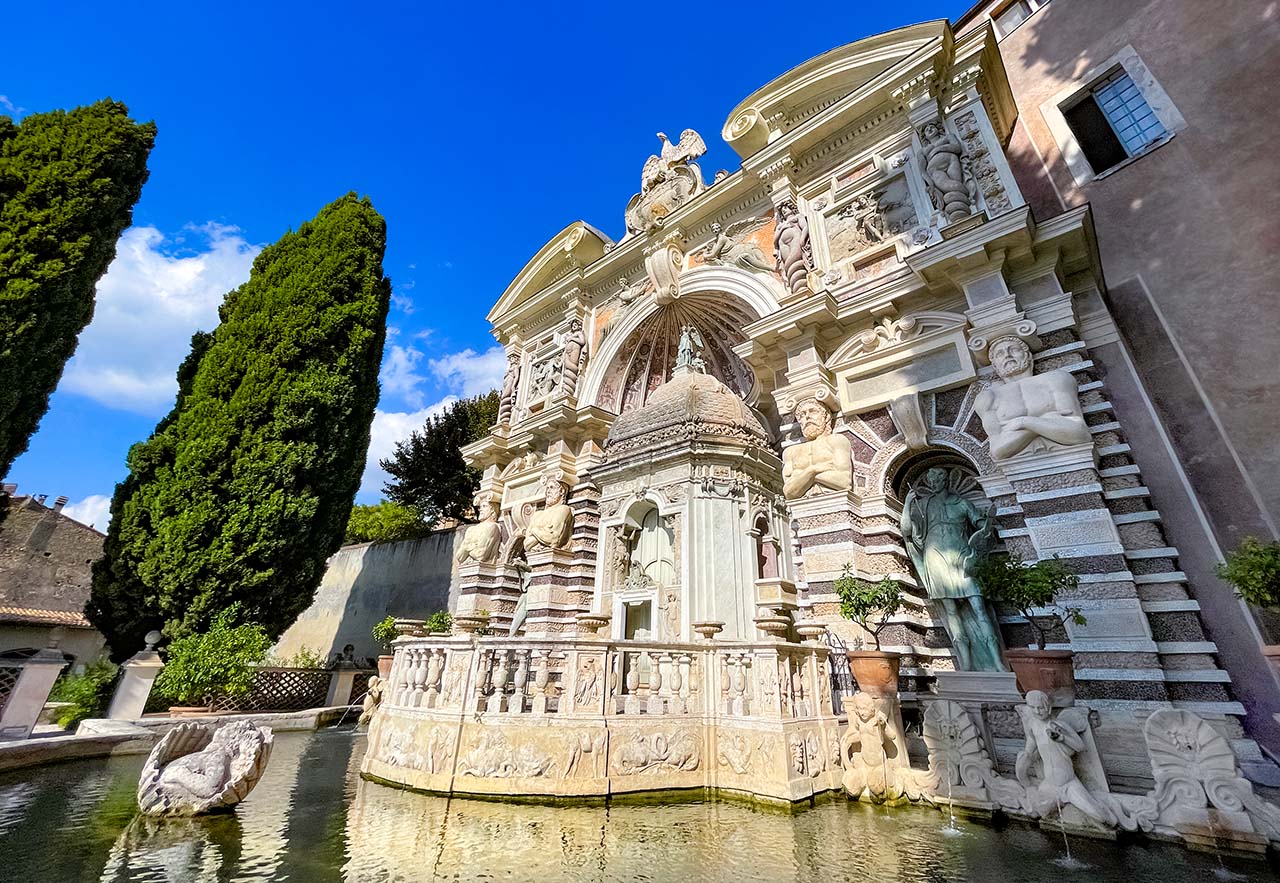
From the majestic ruins of Hadrian’s Villa to the enchanting fountains of Villa d’Este, Tivoli is a treasure trove of Italy’s historical and artistic heritage. Each of these 12 must-see sights in Tivoli offers a unique glimpse into the splendor of ancient Rome and the elegance of the Renaissance. Whether you’re drawn to the intricate garden designs, awe-inspiring frescoes, or the rich history surrounding these UNESCO World Heritage Sites, Tivoli promises a memorable escape into Italy’s past.
Discover Hadrian’s Villa and Villa d’Este:
Tivoli Tours from Rome & Post Cruise Tours to Tivoli
For anyone with a love for history, architecture, or scenic gardens, Tivoli is a dream destination.
At Stefano Rome Tours, we specialize in making your trip to Tivoli an experience of luxury and comfort without the hassles of crowded tour buses or group tours.
Our private day tours from Rome and Post Cruise Tours from Civitavecchia are conducted in deluxe vehicles driven by English-speaking chauffeurs who are knowledgeable about the area and can enhance your visit with local insights.
With Stefano Rome Tours, you can look forward to a seamless day trip to Tivoli. We believe in creating enriching journeys, allowing you to immerse yourself fully in Tivoli's charm, history, and artistry while touring at your own pace without having to keep up with big groups.
Whether you’re captivated by the ancient allure of Hadrian’s Villa or enchanted by the Renaissance elegance of Villa d’Este, our day tours with private drivers provide an unforgettable way to explore these incredible sights.
Why Choose Stefano Rome Tours for Your Tivoli Tour?
With over 20 years of expertise in providing high-quality Tivoli Day Tours from Rome and private excursions from Civitavecchia, Stefano Rome Tours ensures a superior travel experience. Here’s why travelers trust us for their unforgettable Tivoli adventure:
- Luxury Transportation: Our comfortable deluxe vehicles offer a stylish, smooth, and relaxing journey, whether you’re coming from Rome or Civitavecchia.
- Expert English-speaking Drivers: Our licensed, professional drivers provide general insights about your visit to Tivoli’s iconic sites like Hadrian’s Villa and Villa d'Este.
- Convenient Door-to-Door Service: Enjoy seamless pick-up and drop-off at your Rome hotel or Civitavecchia cruise port for a hassle-free start to your tour.

Discover MORE of Italy with Stefano Rome Tours Travel Blog!
- 7 Best Day Trips from Rome: Ideas to Explore the Surrounding Areas
- Enchanted Escapes: Discover the Magic of Tuscania, Ceri, and Bracciano
- Best Autumn Day Trips from Rome: Explore Tuscany, Amalfi Coast, and More
- Etruria's Hidden Depths: The Mystical Journey Through Ancient Etruscan Tombs
- 10 Picturesque Italian Villages to Visit from Rome, Italy
Tivoli awaits you, and with Stefano Rome Tours, your experience will be as enriching as the history itself. Whether you’re a traveler eager to uncover the secrets of Hadrian’s Villa or to lose yourself in the fountains of Villa d’Este, Stefano Rome Tours is here to make your journey extraordinary.
Book your Tivoli tour with us and step into a world where ancient and Renaissance wonders blend seamlessly into one captivating adventure. See you soon in Italy!
The Stefano Rome Tours Team
